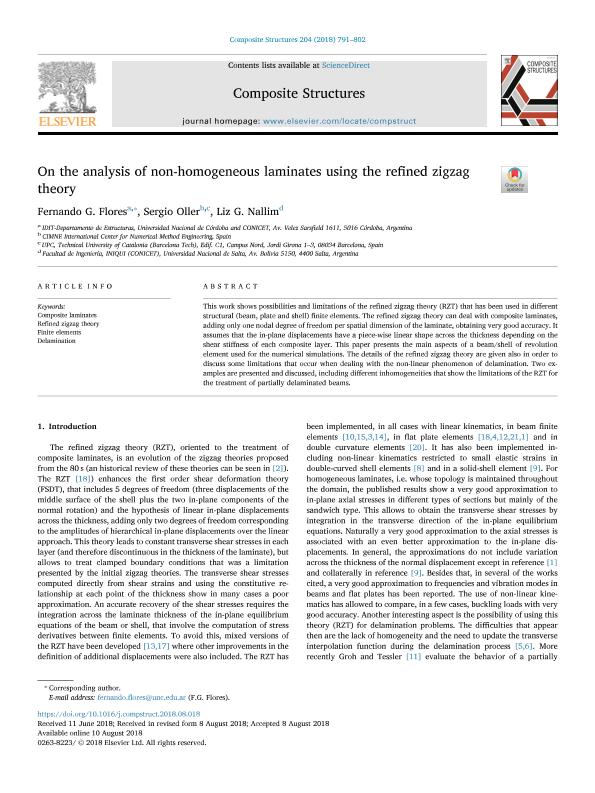Mostrar el registro sencillo del ítem
dc.contributor.author
Flores, Fernando Gabriel

dc.contributor.author
Oller, Sergio Horacio Cristobal

dc.contributor.author
Nallim, Liz

dc.date.available
2019-11-22T14:19:32Z
dc.date.issued
2018-11
dc.identifier.citation
Flores, Fernando Gabriel; Oller, Sergio Horacio Cristobal; Nallim, Liz; On the analysis of non-homogeneous laminates using the refined zigzag theory; Elsevier; Composite Structures; 204; 11-2018; 791-802
dc.identifier.issn
0263-8223
dc.identifier.uri
http://hdl.handle.net/11336/89531
dc.description.abstract
This work shows possibilities and limitations of the refined zigzag theory (RZT) that has been used in different structural (beam, plate and shell) finite elements. The refined zigzag theory can deal with composite laminates, adding only one nodal degree of freedom per spatial dimension of the laminate, obtaining very good accuracy. It assumes that the in-plane displacements have a piece-wise linear shape across the thickness depending on the shear stiffness of each composite layer. This paper presents the main aspects of a beam/shell of revolution element used for the numerical simulations. The details of the refined zigzag theory are given also in order to discuss some limitations that occur when dealing with the non-linear phenomenon of delamination. Two examples are presented and discussed, including different inhomogeneities that show the limitations of the RZT for the treatment of partially delaminated beams.
dc.format
application/pdf
dc.language.iso
eng
dc.publisher
Elsevier

dc.rights
info:eu-repo/semantics/openAccess
dc.rights.uri
https://creativecommons.org/licenses/by-nc-sa/2.5/ar/
dc.subject
COMPOSITE LAMINATES
dc.subject
DELAMINATION
dc.subject
FINITE ELEMENTS
dc.subject
REFINED ZIGZAG THEORY
dc.subject.classification
Ingeniería Estructural

dc.subject.classification
Ingeniería Civil

dc.subject.classification
INGENIERÍAS Y TECNOLOGÍAS

dc.title
On the analysis of non-homogeneous laminates using the refined zigzag theory
dc.type
info:eu-repo/semantics/article
dc.type
info:ar-repo/semantics/artículo
dc.type
info:eu-repo/semantics/publishedVersion
dc.date.updated
2019-10-15T14:58:11Z
dc.journal.volume
204
dc.journal.pagination
791-802
dc.journal.pais
Países Bajos

dc.journal.ciudad
Amsterdam
dc.description.fil
Fil: Flores, Fernando Gabriel. Consejo Nacional de Investigaciones Científicas y Técnicas. Centro Científico Tecnológico Conicet - Córdoba. Instituto de Estudios Avanzados en Ingeniería y Tecnología. Universidad Nacional de Córdoba. Facultad de Ciencias Exactas Físicas y Naturales. Instituto de Estudios Avanzados en Ingeniería y Tecnología; Argentina
dc.description.fil
Fil: Oller, Sergio Horacio Cristobal. International Center for Numerical Method Engineering; España. Technical University of Catalonia; España
dc.description.fil
Fil: Nallim, Liz. Consejo Nacional de Investigaciones Científicas y Técnicas. Centro Científico Tecnológico Conicet - Salta. Instituto de Investigaciones para la Industria Química. Universidad Nacional de Salta. Facultad de Ingeniería. Instituto de Investigaciones para la Industria Química; Argentina
dc.journal.title
Composite Structures

dc.relation.alternativeid
info:eu-repo/semantics/altIdentifier/url/https://www.sciencedirect.com/science/article/pii/S0263822318321251
dc.relation.alternativeid
info:eu-repo/semantics/altIdentifier/doi/https://doi.org/10.1016/j.compstruct.2018.08.018
Archivos asociados
